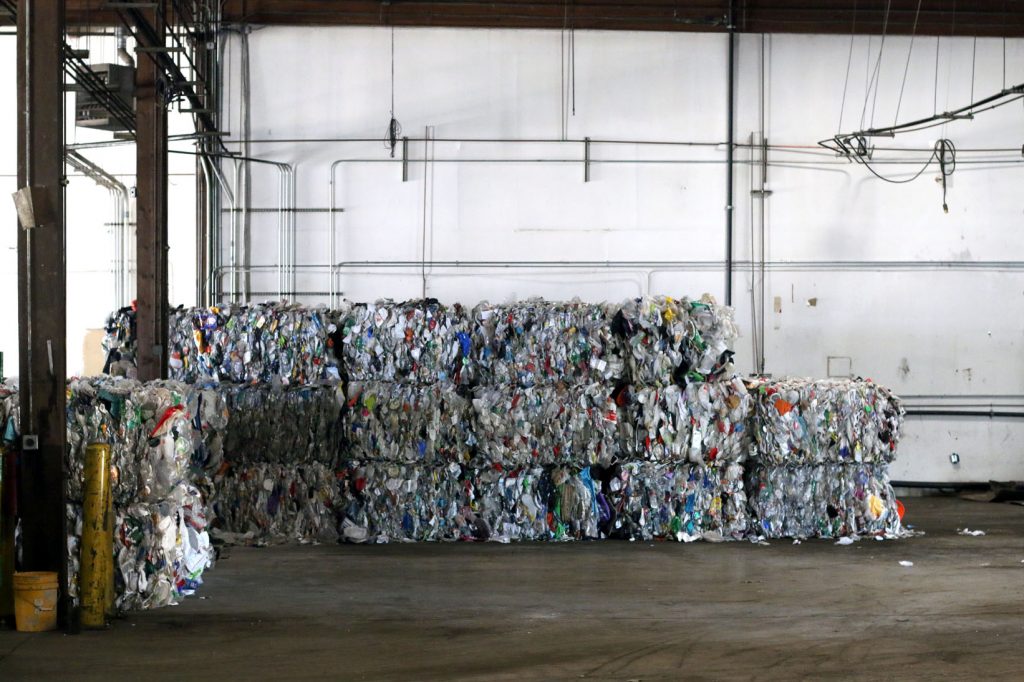
An industry-backed demonstration project is taking place at a former Far West Recycling facility in Portland, Ore. | Jared Paben / Resource Recycling, Inc.
Last week marked the start of a two-month effort to sort a variety of resins from loads of material otherwise bound for disposal. The goal is to develop a pool of data that can help guide future industry investments.
The Pacific Northwest Secondary Sorting Demonstration Project is in the middle of its 60-day run, operating in a shuttered recycling center in Portland, Ore. Equipment from Titus MRF Services was transported up from Los Angeles, and the project is currently working through loads of material provided by several materials recovery facilities (MRFs).
Led by the Plastics Industry Association, the project is also sponsored by the American Chemistry Council (ACC), Americas Styrenics (AmSty), Berry Global, the Carton Council, LyondellBasell, the Metro regional government that covers the Portland metropolitan area, and industrial products manufacturer Milliken.
The volume and variety of funding organizations “speaks to the breadth of interest” from different sectors, said Kim Holmes, vice president of sustainability for the Plastics Industry Association.
The project was announced in June.
Data is the driver
At a warehouse that formerly housed a recycling center operated by Far West Recycling, the secondary sort project will work through four separate 40-ton loads of material, or 160 tons in all.
The inbound stream is MRF residue otherwise destined for disposal. The secondary facility is taking that material and using sorting equipment to further separate it to recover additional value.
The 160 tons is a relatively small volume, but it’s a sample size that will generate data that can be generalized for wider application. The Portland project is separating out six streams of material: PET, HDPE, LDPE, PP, PS, and gable ton and aseptic cartons.
Material is coming in from several MRFs around the Pacific Northwest, including facilities operated by Far West, Waste Connections and others.
(Story continues below slideshow. Hover over a photo to bring up arrows that allow you to advance through the sequence.)
This project is primarily geared toward developing an in-depth look at the types of recyclables that are for one reason or another not being recovered by MRFs, Holmes explained during an Aug. 1 tour. The resulting information can be used to help stakeholders make more informed decisions about investing in processing infrastructure, end markets and recycling technology.
Over the last year, a variety of entities have shown interest in putting more capital behind materials recovery as recycling and pollution concerns have been amplified in the media. Having better data about what MRFs are sending to landfill and incineration could help investors make wiser choices.
“Every pound of material will be accounted for in the final report,” Holmes said, noting the final analysis will be made public and will just present the numbers, not specific investment recommendations.
The project will run trials through the end of August, and the report is slated for completion in October.
California facility provides model
Titus MRF Services operates a commercial-scale secondary sorting facility in Los Angeles, the only facility of its kind in the U.S. Under a secondary sorting model, the idea is that a single facility taking in material from many MRFs throughout a region could operate with benefits of scale. For a single MRF, it might not make sense to invest in equipment to effectively recover material that makes up a very small portion of the stream, but with a larger concentration of that material, the economics could pencil out.
Under the Titus model, MRFs pay a toll fee to the secondary sorting facility – a sum that’s lower than the local landfill tip fee.
Depending on a variety of factors, including material and market conditions, the secondary sorting facility shares commodity sales revenue with the MRF supplying the material. Ideally, the model provides a cheaper way for MRFs to get rid of material they aren’t recovering and generates a greater volume of sorted recyclables.
If the secondary sort idea were to be brought to other markets, the model would likely vary significantly based on region, given differences in what recycling programs accept, the presence or lack of a container deposit, MRF sorting procedures and more.
As for where the material from the Portland pilot project will go after it’s sorted and tabulated, a number of end users have expressed interest. According to Holmes, Exxon Mobil has asked for the PE; Loop Industries is interested in the low-grade PET; Regenyx (a partnership of AmSty and chemical recycling firm Agilyx) will take the PS; Exxon Mobil and chemical recycling company Renewlogy are interested in the recovered film; and Berry Global will take the PP.
Impetus for study
The world of plastics recycling is changing and the industry will look very different in the years to come, Holmes said. The secondary sorting project is an example of one model that could emerge. There’s no one solution for the challenges facing the recycling industry, she added, but the idea is that the secondary sorting facility concept could be one of several tools.
The secondary sorting model could tackle several challenges facing the recycling sector. For instance, it could help MRFs adapt to the ever-changing material stream, Holmes said, by enabling recovery of different types of material without requiring investments in each MRF.
A secondary sort could also help the industry address another emerging challenge. There has been unprecedented investment from brand owners in recycling companies, as well as unprecedented recycled-content commitments from brand owners, but all signs indicate that without a significant increase in recycling rates there will be insufficient supply of recycled material available for brand owners to meet their goals.
To receive the latest news and analysis about plastics recycling technologies, sign up now for our free monthly Plastics Recycling Update: Technology Edition e-newsletter.
More stories about processing